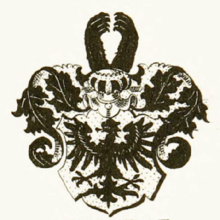Raschau (noble family)
Raschau is the name of an extinct Saxon , Thuringian and Hessian noble family . It is not to be confused with the noble families Raschke, Raschkow, Raschkau and Raschen.
Expansion and possessions
In 1224, Heinricus de Ratschau can be traced for the first time on the manor house of the same name (today Raschau ) near the town of Oelsnitz in Vogtland.
At the end of the 14th century, Eberhard von Raschau owned goods at Schönbrunn near Oelsnitz. The von Raschau family moved to Osterland in 1401 , where they were documented in the 19th century. One line turned to the Baltic States , first to the island of Oesel . In 1466 Nikolaus Raschau was one of the signatories of the Peace of Thorn . Samuel Johan von Raschau (1677–1727), captain in the Schlippenbach dragoon regiment, married Maria Amalia, daughter of the Rostock-born Swedish diplomat Joachim Krebs, in Moscow in 1710 and died in Russian captivity. His widow died on the island of Oesel in 1735.
The origins were probably in Franconia , since the initial hereditary burial was in Waldsassen . The first known ancestors of the family appear in 1194 in the entourage of Emperor Heinrich VI. the brothers Eckehard and Heinrich to Nuremberg. Heinrich was present as advocatus (Vogt) in 1209 when the Mildenfurth monastery was founded . In the 13th century the family named themselves after the castle Straßberg (Vogtland) (Vögte) von Straßberg and then also after the castle Voigtsberg von Vogtsberg . Dynastically, the family, which belonged to the imperial ministry in the high Middle Ages , was also connected to the dynasty of the governors of Weida, Gera and Plauen . So Vogt Heinrich I von Plauen was a son of Jutta, born from Straßberg. In the 14th century the name Raschau was adopted after the village of the same name: In 1366 Hans von Raschau acknowledged the burgrave of Nuremberg and sealed it with the coat of arms of his father Eberhard von Vogtsberg. In 1478 Mathes von Raschau zu Püchersreuth and other sayers ended a legal dispute between the abbot of Waldsassen and the hammer master zu Falkenberg.
In 1604 David von Raschau was court advisor in Gera . Another representative of the sex is the electoral provisions and cavalry master Christoph von Raschau on Crimmeln, Frießnitz , Greuth and Niederpöllnitz . In 1650 there were representatives of the zu Sinderstedt family, in 1688 in Tromlitz and from 1694 to 1771 in Leumnitz .
From 1729 to 1752 the Lehngut Nausitz belonged to the von Raschau family. Representatives of the family can be found in Posern and Stoß in 1750, in Battgendorf in 1781 and in what is now Bad Sulza . As recently as 1857, the von Raschau were resident in Posern and Pobles in the Prussian province of Saxony . Later the noble family died out in the male line.
coat of arms
Blazon : a black eagle in gold. At first, as with the ancestors, the bailiffs von Straßberg and von Vogtsberg, the eagle also covered by a sloping ledge (a "street"). On the helmet with black and gold covers, two black bear paws facing each other.
Representative
- Charlotte Rahel von Raschau b. von Rostock (1772–1830) married the Prussian general Constantin von Lossau after their divorce
literature
- Ernst Heinrich Kneschke : New general German nobility lexicon . Volume 7, Friedrich Voigt's Buchhandlung, Leipzig 1868, p. 346.
- Leopold von Zedlitz-Neukirch : New Prussian Adelslexicon . Volume 4, Gebrüder Reichenbach, Leipzig, p. 87.
- Ulrich Otto, Die Vögte von Straßberg , in: Deutsche Münzblätter , No. 411, 57th year, March 1937, pp. 265–273 and plate 174
Individual evidence
- ↑ HOV Saxony
- ↑ [1]
- ↑ [2]
- ↑ [3]
- ↑ [4]
- ↑ Straßberg in Vogtland
- ↑ The Lords of Dewin on Sorau and the Counts of Klettenberg, [5]
- ↑ [6]
- ↑ [7]
- ↑ [8]
- ^ Ernst Heinrich Kneschke : New general German nobility lexicon . Volume 7, Friedrich Voigt's Buchhandlung, Leipzig 1868, p. 346.
- ↑ Ulrich Otto, Die Vögte von Straßberg , in: Deutsche Münzblätter , No. 411, 57th year, March 1937, pp. 265–273; see. there plate 174
